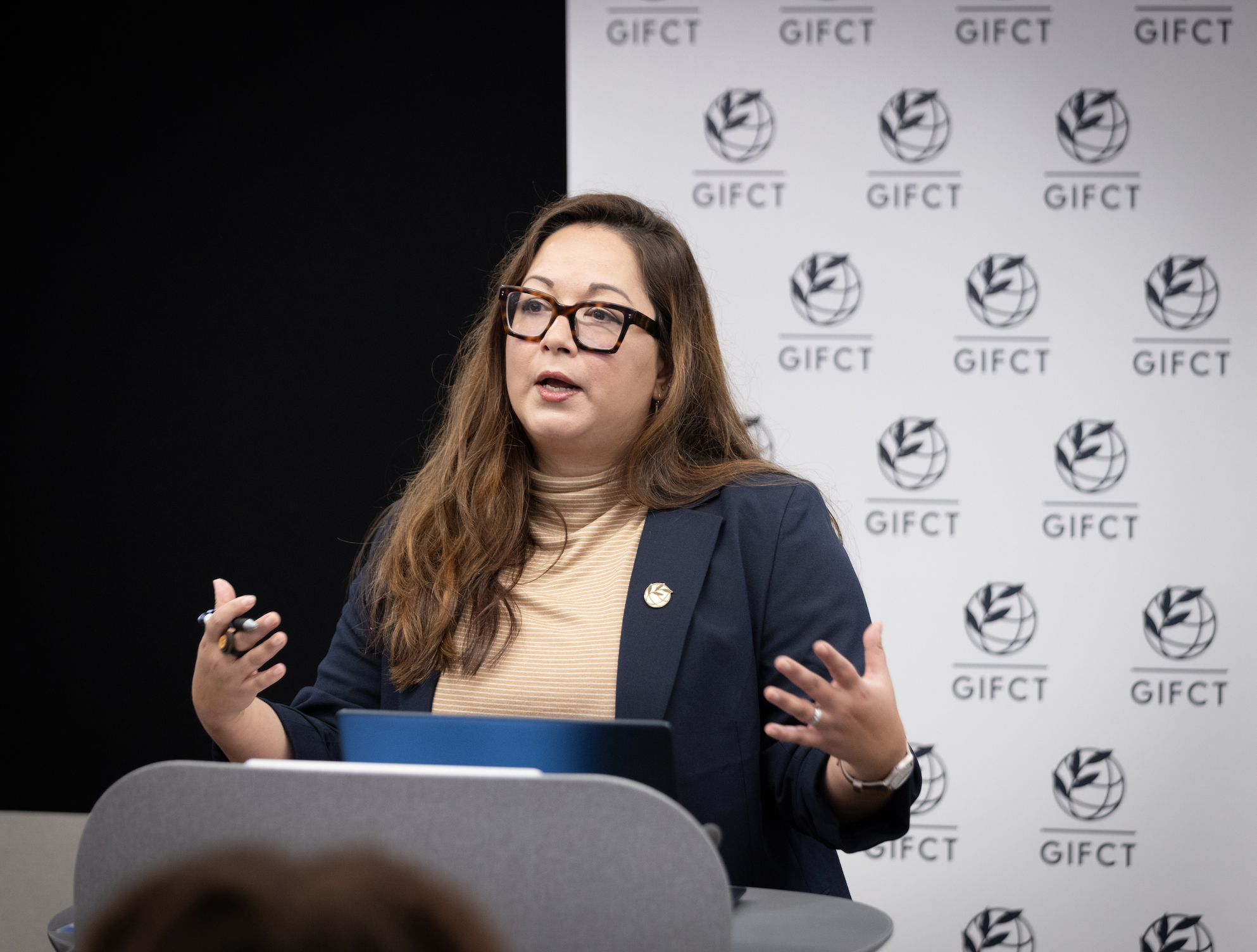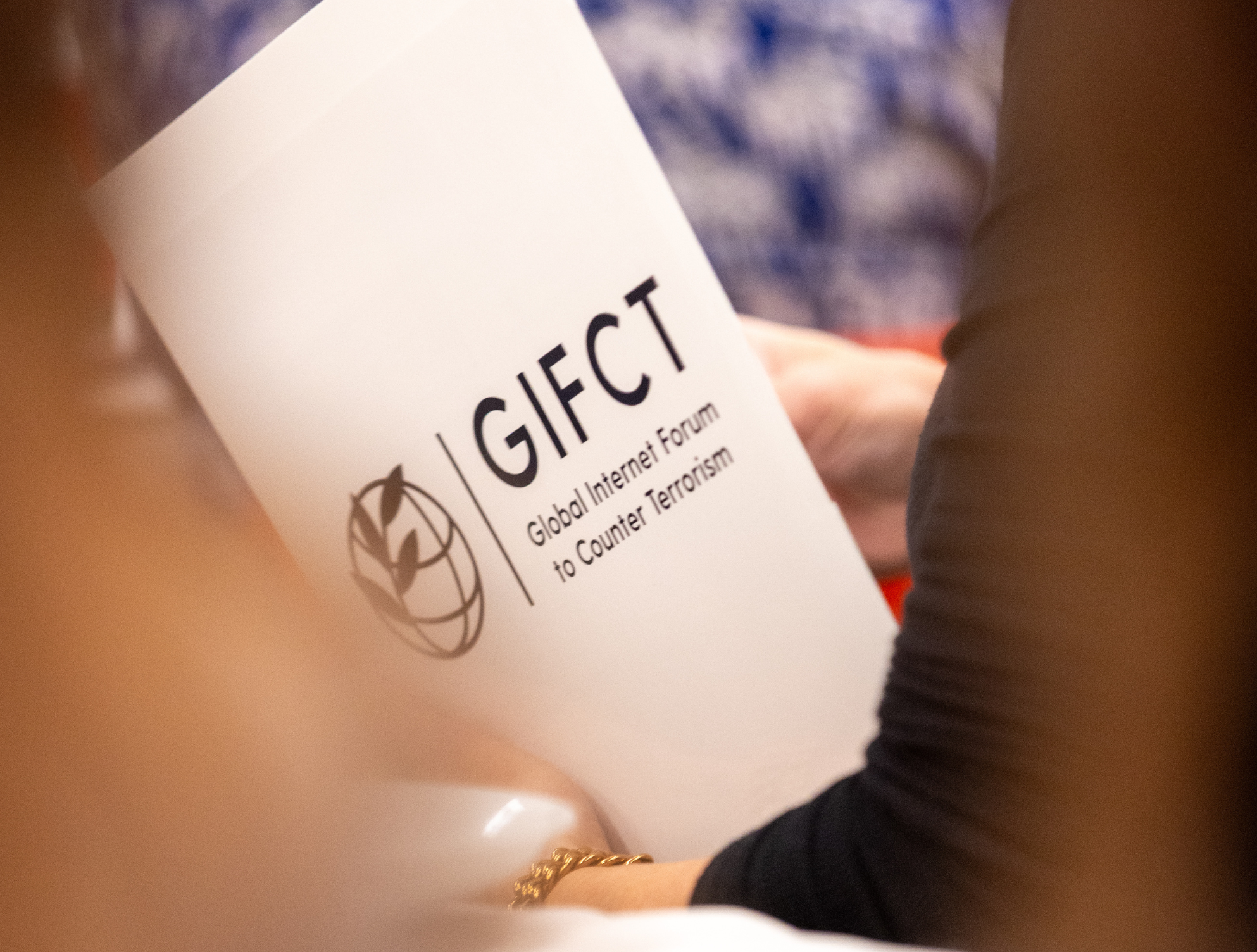The Global Internet Forum to Counter Terrorism (GIFCT) recently convened its 2025 Annual Member Forum, hosted in partnership with its Operating Board Chair, YouTube. The event brought together representatives from GIFCT’s 39 member companies, the Operating Board, and the Independent Advisory Committee (IAC) for a day of sharing insights, collaboration, and forward planning.
This event was held strictly under the Chatham House Rule.
Welcome Remarks and Fireside Chat
The opening fireside chat brought together GIFCT Executive Director Naureen Chowdhury Fink, Operating Board Chair and Vice President of Government Affairs and Public Policy at YouTube, Leslie Miller, and IAC Chair, Jonathan Russell, to take stock of a year defined by transformation and growth. 2025 has been marked by the expansion of tools, partnerships, and vision that have solidified GIFCT’s member-centric approach and strengthened its impact across a growing network of 39 companies. With six new members this year, a revised Incident Response Framework (IRF), the new in-house Membership Advisory Program, and new human rights training resources, GIFCT enters 2026 with renewed purpose and a furthered commitment to serve its member community. GIFCT has evolved into an increasingly independent organization now taking proactive steps to address the challenges posed by an ever-evolving threat landscape. As online and offline harms continue to converge, signal sharing, behavior-based prevention, and stronger multistakeholder collaboration remain essential to preventing terrorists and violent extremists from exploiting digital spaces. Engagement across industry, civil society, and government, including through the Independent Advisory Committee, helps ensure GIFCT’s work is grounded in diverse expertise.

GIFCT Executive Director Naureen Chowdhury Fink
Board Updates and Elections
Following the fireside chat, the focus turned to governance and the ongoing evolution of GIFCT’s Operating Board. The session offered GIFCT members a window into how the Board offers GIFCT strategic advice and direction, and informs its activities—balancing oversight with the collaborative approach that defines the organization. Updates to the governance structure in 2024 highlighted the Board’s recognition of the importance of maintaining a diverse and engaged leadership structure. Board members were invited to share their perspectives on the Board’s role and journey, and reflect on the opportunities for general members to stand for election to the Board. Operating Board members reaffirmed that collaboration remains at the core of GIFCT’s mission, noting how multistakeholder engagement has strengthened initiatives like the IRF and enhanced the organization’s global reach through high-level engagements, including this year’s UN General Assembly side event and workshops in several regions.
Following remarks from the Operating Board, two GIFCT member companies stepped forward to stand for elections, outlining their priorities and expressing commitment to strengthening member collaboration and continuing to advance responsible approaches to trust and safety. The outcomes of the election will be announced following the conclusion of the voting process.

Reflections from GIFCT’s Operating Board
Compass Preview
Reflecting member and stakeholder feedback, GIFCT has developed an internal portal for industry members to centralize and streamline access to key resources; it is anticipated to go live before the end of the year. Compass, the new portal, was presented to the membership by Skip Gilmour, GIFCT’s Director of Trust and Safety Solutions. It will serve as a secure hub for bespoke knowledge products, intel bulletins, guidebooks, and a Wiki of IRF-activation events and actors—all tailored to support GIFCT members. The presentation demonstrated key features of the interface, which will also include links to related resources, as well as integrated intelligence and analysis sections featuring Insights and reports from GIFCT’s academic research arm, the Global Network on Extremism and Technology (GNET).
The platform has been built not only to host information, but to evolve with member input—inviting companies to propose new features, contribute resources, and help shape the next generation of shared tools.

Threat Landscape Panel
Overview of the Threat Landscape
The next session turned attention to the rapidly evolving threat landscape and the implications for GIFCT member companies. Moderated by Dr. Erin Saltman, GIFCT’s Senior Director for Membership and Programs, the discussion brought together representatives from Anthropic, Dropbox, and the IAC to share industry and stakeholder perspectives on trends and solutions, including potential priorities for the forthcoming year.
Emerging trends, as highlighted by speakers, include acceleration in the radicalization of young people, with cases appearing at increasingly younger ages and within shorter timeframes compared to previous iterations of terrorist threats—sometimes unfolding over mere weeks rather than months or years. Relatedly, there has been a rise of subcultures fixated on extreme violence and gore, martyrdom narratives, and the glorification of perpetrators, often detached from coherent ideological narratives and targeting youth through “gamified” aesthetics and approaches. This “post-ideological” fascination with destruction, warned some speakers, presents new challenges for detection and intervention and creates uncertainty among governments about how best to adapt existing frameworks to these shifting dynamics.
The advancement of AI continues to pose both risk and opportunity for trust and safety efforts, some panelists highlighted. The same technologies enabling creative and productive use cases can also be misused by bad actors operating in fragmented or private spaces. The low barrier to entry and speed of model improvement have heightened concerns around emerging misuse, so the need for safeguards and friction—e.g., embedding safety measures during model training and maintaining ongoing monitoring after deployment—while also exploring ways to identify early risk factors, need to be holistically applied for optimal impact.
The discussion closed on a note of cautious optimism. Members were appreciative of this year’s Working Group themes speaking to the ongoing and evolving threat landscape that analyzed AI threats and opportunities, youth radicalization, and investigation practices. As participants looked ahead to 2026, they underscored the importance of collaboration, shared intelligence, and innovation in adapting to a threat landscape that is not only evolving—but accelerating.

Tech-Stack Specific Breakout Discussions
Tech-Stack Specific Feedback Session
Following the threat landscape panel, participants engaged in tech-stack specific breakout discussions tailored to the unique architectures and operational challenges of different platform types. These sessions provided a semi-structured forum for members to identify shared needs, exchange practical insights, and inform GIFCT’s future priorities across its Working Groups, research agenda, and member support initiatives.
Audio
Participants discussed potential applications of a shared dataset of identified terrorist audio files—from sharing audio related signals as a part of GIFCT’s broader suite of collaborative solutions to using the data as seed content for developing classifiers. The conversation underscored the importance of detecting contextual signals such as lyrics, podcast content, speeches, or the reuse of audio from violent incidents. Members also highlighted the need for improved language coverage, keyword-based detection methods, and streamlined signal sharing.
Gaming
The gaming group focused its attention on the complex and highly networked nature of violent extremist activity in gaming environments. Participants noted that exploitation in these spaces often forms part of a broader cross-platform strategy, making it essential to better understand how behaviors and users move between services. The discussion emphasized the value of shared resources and case studies to inform and improve future trust and safety efforts.
Fintech/Marketplace
In the financial technologies (or “fintech”) breakout group, members focused on the distinct challenges of detecting and disrupting terrorist financing through digital payment and fundraising platforms. Given the limited visibility into user behaviors compared to traditional content environments, participants stressed the need for cross-platform and sector partnerships and the importance of clearly defined guidance as it relates to signal sharing in this space.
URL Sharing
The URL sharing discussion addressed one of the most persistent and cross-cutting challenges in online safety—the use of links to evade moderation and sustain extremist networks across platforms. Members offered feedback on an upcoming pilot project, sharing insights on governance, safeguards, and interoperability. The project aims to strengthen collaboration between trust and safety teams so they can more effectively disrupt cross-platform dissemination tactics.
TTX Exercise + IRF Updates
The afternoon continued with an interactive tabletop exercise session focused on GIFCT’s recently updated IRF. Facilitated by GIFCT’s Trust and Safety Solutions Team in partnership with Extremisphere, the session combined a refresher on the newly enhanced IRF structure with a hands-on exercise designed to strengthen member readiness and cross-platform collaboration during live incident scenarios.

2025 GIFCT Annual Member Forum
Closing Remarks and Year Ahead
In closing, Executive Director Naureen Chowdhury Fink reflected on a year of transformation and shared progress across GIFCT’s work in 2025. The threat landscape, she noted, continues to evolve at pace, which requires staying alert to emerging trends, shifting dynamics, and new opportunities for mitigation. As adversaries adapt, the need for strong cross platform collaboration has only become more pressing. She noted three key points that emerged across various sessions:
Constant evolution: The threat landscape is advancing rapidly, demanding sustained attention to emerging trends and mitigation opportunities. Continued adversarial adaptation reinforces the need for strong cross platform collaboration.
Youth: Rising concerns regarding the recruitment and mobilization of young people, alongside younger victim profiles, were widely noted. A deeper understanding of hybrid online subcultures and strengthened cross team coordination remains essential.
Focus on solutions: While clear threat definitions and consistent parameters are necessary, the priority is advancing practical, scalable solutions. Building on established lessons supports more effective and sustainable responses.
As GIFCT looks ahead to 2026, its commitment to transparency, innovation, and preventing the exploitation of digital platforms remains firm, grounded in the shared purpose of its expanding global community.
We thank our 2025 Operating Board Chair, YouTube, for hosting us, and our members and Independent Advisory Committee for joining this year’s forum to share critical insights and shape the year ahead.


